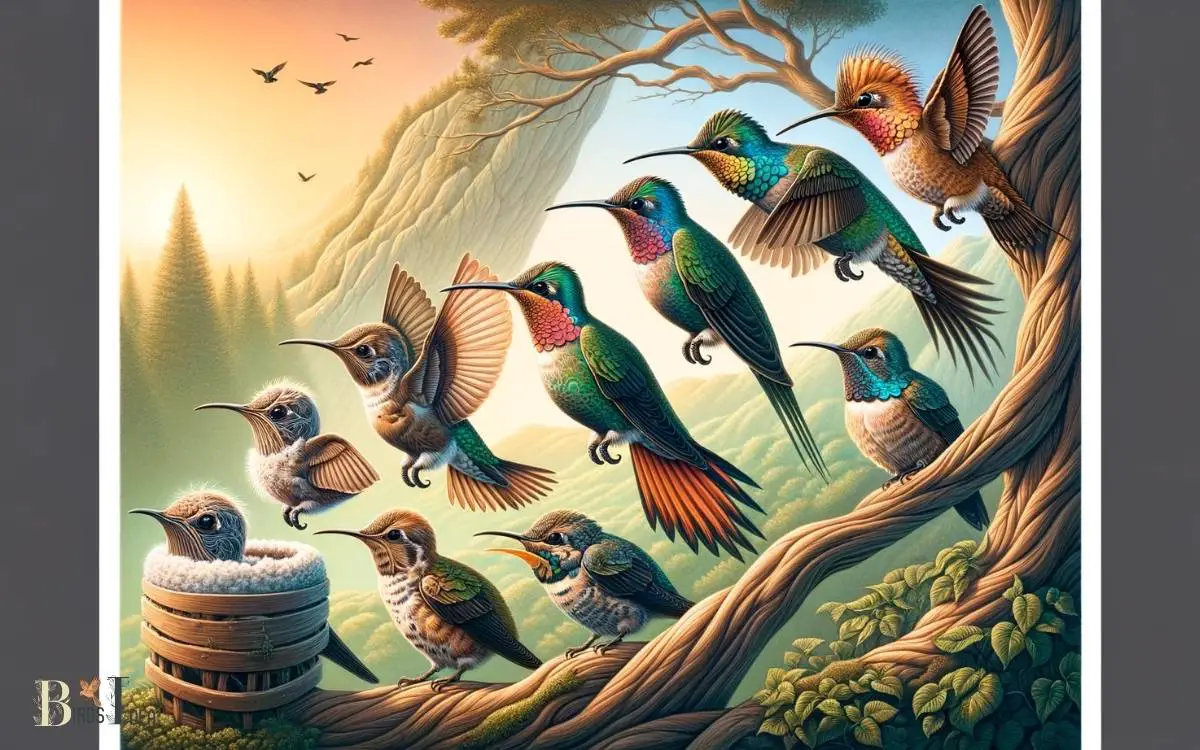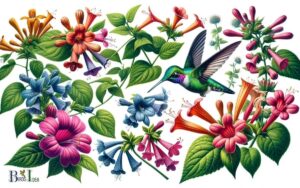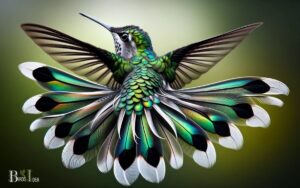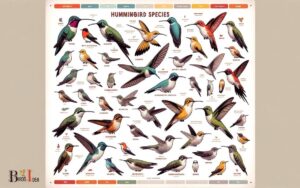How Long Do Anna’s Hummingbirds Live? 3 to 5 Years!
Anna’s Hummingbirds typically have a lifespan ranging from 3 to 5 years in the wild; however, their life expectancy can be influenced by various factors such as predation, habitat conditions, and availability of food resources.
Anna’s Hummingbirds (Calypte anna) are a species known for their remarkable resilience and adaptability to different environments, one of the factors contributing to their relatively long lifespan for a bird of their size.
Various factors can impact the lifespan of Anna’s Hummingbirds:
In captivity, with threats like predation and food scarcity managed, these hummingbirds may live longer, sometimes up to 9 years or more.
Example:
An Anna’s Hummingbird nesting in a well-planted suburban backyard with feeders may enjoy a longer life due to the reduced number of predators and steady food supply, compared to one living in a sparse desert habitat.
Encountering an Anna’s Hummingbird can be a delightful experience, as these birds are known for their vivid emerald feathers and energetic flight patterns.

Key Takeaway
Anna’s Hummingbirds: A Brief Overview
Anna’s Hummingbirds are found primarily on the western coast of North America, from southern Canada to northern Baja California, Mexico.
These striking birds are renowned for their iridescent green plumage and the vibrant pink-red feathers found on the throats of males.
They are small in size, measuring around 3.9 to 4.3 inches in length and weighing approximately 0.1 to 0.2 ounces.
Their preferred habitats include open woodlands, gardens, and scrublands. Anna’s Hummingbirds are known for their agility and speed, being capable of hovering, flying backward, and even upside down.
Their diet primarily consists of nectar from flowers, supplemented with insects and spiders for protein. These remarkable birds are a delight to observe and play a vital role in pollination within their ecosystems.
Lifespan of Anna’s Hummingbirds
The lifespan of Anna’s Hummingbirds is a topic of interest for researchers and enthusiasts alike.
Understanding the average lifespan of these birds in the wild, as well as the factors that affect their longevity, is crucial for gaining insights into their life history and population dynamics.
By examining these aspects, we can better appreciate the resilience and adaptability of Anna’s Hummingbirds in their natural habitat.
Average Lifespan in Wild
An Anna’s hummingbird in the wild typically has an average lifespan of 3 to 5 years. This relatively short lifespan can be attributed to various factors such as predation, diseases, and environmental hazards.
The following factors contribute to the average lifespan of Anna’s hummingbirds in the wild:
- Predation: Natural predators such as snakes, lizards, and birds of prey pose a constant threat to the survival of Anna’s hummingbirds, limiting their lifespan in the wild.
- Diseases: In the wild, Anna’s hummingbirds are susceptible to various diseases and parasites which can significantly impact their longevity.
- Environmental Hazards: Harsh weather conditions, loss of habitat, and competition for resources are environmental factors that can affect the average lifespan of Anna’s hummingbirds in the wild.
Factors Affecting Longevity
In assessing the factors influencing the lifespan of Anna’s hummingbirds, it is crucial to consider the impact of predation, diseases, and environmental hazards on their longevity in the wild.
Predation poses a significant threat to the lifespan of Anna’s hummingbirds, with natural predators such as snakes, larger birds, and mammals posing a constant risk to their survival.
Additionally, diseases, particularly those spread by other bird species, can also impact their longevity.
Environmental hazards, including extreme weather events, habitat loss, and exposure to pesticides, further contribute to the challenges these hummingbirds face in maintaining a long lifespan.
Understanding and mitigating these factors are essential for the conservation and protection of Anna’s hummingbirds in their natural habitat.
Factors Affecting Longevity
Most factors affecting the longevity of Anna’s Hummingbirds can be attributed to environmental conditions and predation risks.
- Habitat Quality: The availability of suitable nesting sites, access to nectar sources, and the presence of adequate shelter from extreme weather conditions significantly impact the survival rates of Anna’s Hummingbirds.
- Predation: The risk of predation from various predators, such as snakes, birds of prey, and domestic cats, can influence the longevity of Anna’s Hummingbirds. Predation risk is particularly high during nesting and foraging activities.
- Climate Change: Environmental changes, including shifts in temperature, precipitation patterns, and plant phenology, can affect the availability of food resources and nesting sites, potentially impacting the survival and longevity of these hummingbirds.
Understanding these factors is crucial for conservation efforts aimed at promoting the longevity of Anna’s Hummingbirds.
Mating and Reproduction
When considering the mating and reproduction behaviors of Anna’s Hummingbirds, it is essential to examine their breeding and nesting habits, courtship displays and rituals, as well as factors contributing to their reproductive success.
These aspects play a crucial role in understanding the species’ reproductive behavior and population dynamics.
By exploring these points, we can gain valuable insights into the unique mating strategies and reproductive patterns of Anna’s Hummingbirds.
Breeding and Nesting Habits
Breeding and nesting habits of Anna’s Hummingbirds are characterized by their intricate courtship displays and meticulous nest construction.
- Courtship Displays: Male Anna’s Hummingbirds perform elaborate aerial displays to attract females. These displays involve steep dives, U-shaped flights, and chirping sounds to establish dominance and attract a mate.
- Nest Construction: Female Anna’s Hummingbirds are solely responsible for nest construction. They use plant material, spider silk, and other fine fibers to build small, cup-shaped nests, often incorporating lichens and mosses for camouflage.
- Reproductive Behavior: After mating, female Anna’s Hummingbirds lay 2-3 white, pea-sized eggs in the nest, which they incubate for about 16-18 days. The female cares for the young until they fledge, usually around 20-22 days after hatching.
Courtship Displays and Rituals
Characterized by intricate courtship displays and meticulous nest construction, the mating and reproduction behaviors of Anna’s Hummingbirds are marked by the male’s elaborate aerial displays and the female’s responsibility for nest construction and care of the young.
During courtship, males perform impressive aerial displays, flying in a U-shaped pattern while producing a high-pitched sound with their tail feathers. These displays are intended to attract females and demonstrate the male’s fitness.
Once a female selects a mate, she takes on the task of building the nest, usually in a high, sheltered location. The female also solely incubates the eggs and cares for the young after hatching.
This division of labor is a key aspect of their reproductive behavior, ensuring the survival of their offspring. These courtship displays and nesting behaviors greatly contribute to the reproductive success of Anna’s Hummingbirds.
Reproductive Success Factors
Marked by the male’s elaborate aerial displays and the female’s responsibility for nest construction and care of the young, the reproductive success of Anna’s Hummingbirds hinges on a delicate balance of mating behaviors and meticulous nesting strategies.
- Mating Rituals: The male Anna’s Hummingbird performs elaborate aerial displays to attract a mate. These displays involve rapid dives and steep arcs, which not only demonstrate the male’s agility but also signal his fitness as a potential partner.
- Nesting Site Selection: Female Anna’s Hummingbirds meticulously select nesting sites, often preferring locations with ample food sources and suitable shelter.
- Parental Care: Once the eggs are laid, the female assumes primary responsibility for incubation and caring for the hatchlings. This crucial phase demands constant attention to ensure the young hummingbirds’ survival.
Diet and Nutrition
Anna’s hummingbirds primarily consume nectar from a variety of flowering plants, supplemented with small insects and spiders for protein. Their diet is crucial to their survival and affects their overall health and reproductive success.
The following table provides an overview of the key components of Anna’s hummingbirds’ diet and their nutritional benefits:
| Diet Component | Nutritional Benefit | Food Source |
|---|---|---|
| Nectar | High energy source | Flowering plants |
| Insects | Protein and essential nutrients | Small insects and spiders |
| Pollen | Amino acids, lipids, vitamins, and minerals | Flowering plants |
| Sap | Sugars, amino acids, and minerals | Sap wells on trees |
| Fruit Juice | Sugars, vitamins, and antioxidants | Ripe fruits |
Understanding the dietary habits of Anna’s hummingbirds is essential for their conservation and management. This knowledge can help ensure the availability of suitable food sources in their habitats.
Predators and Threats
The dietary habits of Anna’s hummingbirds play a significant role in their vulnerability to various predators and threats, as their nutritional intake directly impacts their overall health and ability to evade potential dangers in their environment.
- Predators: Small birds of prey such as kestrels and merlins pose a threat to Anna’s hummingbirds, especially during nesting and foraging.
- Invasive Species: Feral cats and rats, known for preying on small birds, also pose a threat to the Anna’s hummingbird population.
- Habitat Loss: Deforestation and urbanization lead to habitat loss, reducing the availability of suitable nesting sites and food sources for Anna’s hummingbirds.
Understanding these threats is crucial for the conservation of Anna’s hummingbirds. Now, let’s explore the human impact and conservation efforts to ensure the survival of this remarkable species.
Human Impact and Conservation
Human activity has significantly impacted the natural habitats and population dynamics of Anna’s hummingbirds, leading to increased conservation efforts to mitigate these effects.
Urbanization, deforestation, and climate change have led to habitat loss and fragmentation, disrupting the availability of suitable nesting sites and food sources for these birds.
Collisions with human-made structures, such as buildings and vehicles, also pose a significant threat to their populations.
Pesticide use further jeopardizes their survival by contaminating their food sources and causing direct harm.
Conservation efforts include habitat restoration, establishment of protected areas, and public education to raise awareness about the impact of human activities on these birds.
Additionally, measures to reduce collisions with structures and minimize pesticide use are being implemented to ensure the long-term survival of Anna’s hummingbirds.
Supporting Anna’s Hummingbirds
With human activity posing significant threats to the natural habitats and population dynamics of Anna’s hummingbirds, it is crucial for individuals and communities to actively support conservation efforts for these birds.
Supporting Anna’s Hummingbirds can be achieved through the following measures:
- Habitat Preservation: Protecting and preserving the natural habitats of Anna’s hummingbirds is vital for their survival. This includes conserving native plants and creating suitable nesting and foraging areas.
- Education and Awareness: Increasing public awareness about the importance of these birds and the threats they face can lead to greater support for conservation efforts.
- Reducing Human Impact: Minimizing the use of pesticides, providing food sources such as nectar feeders, and preventing window collisions can help reduce human-related threats to Anna’s hummingbirds.
Conclusion and Takeaways
To summarize, active participation in conservation efforts is pivotal for ensuring the long-term survival of Anna’s hummingbirds.
Understanding the factors that influence their lifespan, such as predation, habitat loss, and climate change, underscores the importance of proactive conservation measures.
Protecting and restoring their natural habitats, reducing pesticide use, and implementing bird-friendly practices are essential for supporting Anna’s hummingbirds.
Furthermore, fostering public awareness and engagement is crucial for promoting their conservation. Research on their longevity provides valuable insights into population dynamics and ecological health.
By integrating scientific knowledge with practical conservation actions, we can contribute to the preservation of this remarkable species for future generations.
This underscores the significance of collaborative efforts among scientists, policymakers, and the public to safeguard the longevity and well-being of Anna’s hummingbirds.
Conclusion
The average lifespan of Anna’s hummingbirds is approximately 3-5 years, with some individuals living up to 8 years.
It is important to note that the threats posed by predators, loss of habitat, and human impact significantly affect the population and longevity of these hummingbirds.
Conservation efforts and habitat preservation are crucial in ensuring the survival of Anna’s hummingbirds for future generations to enjoy.






